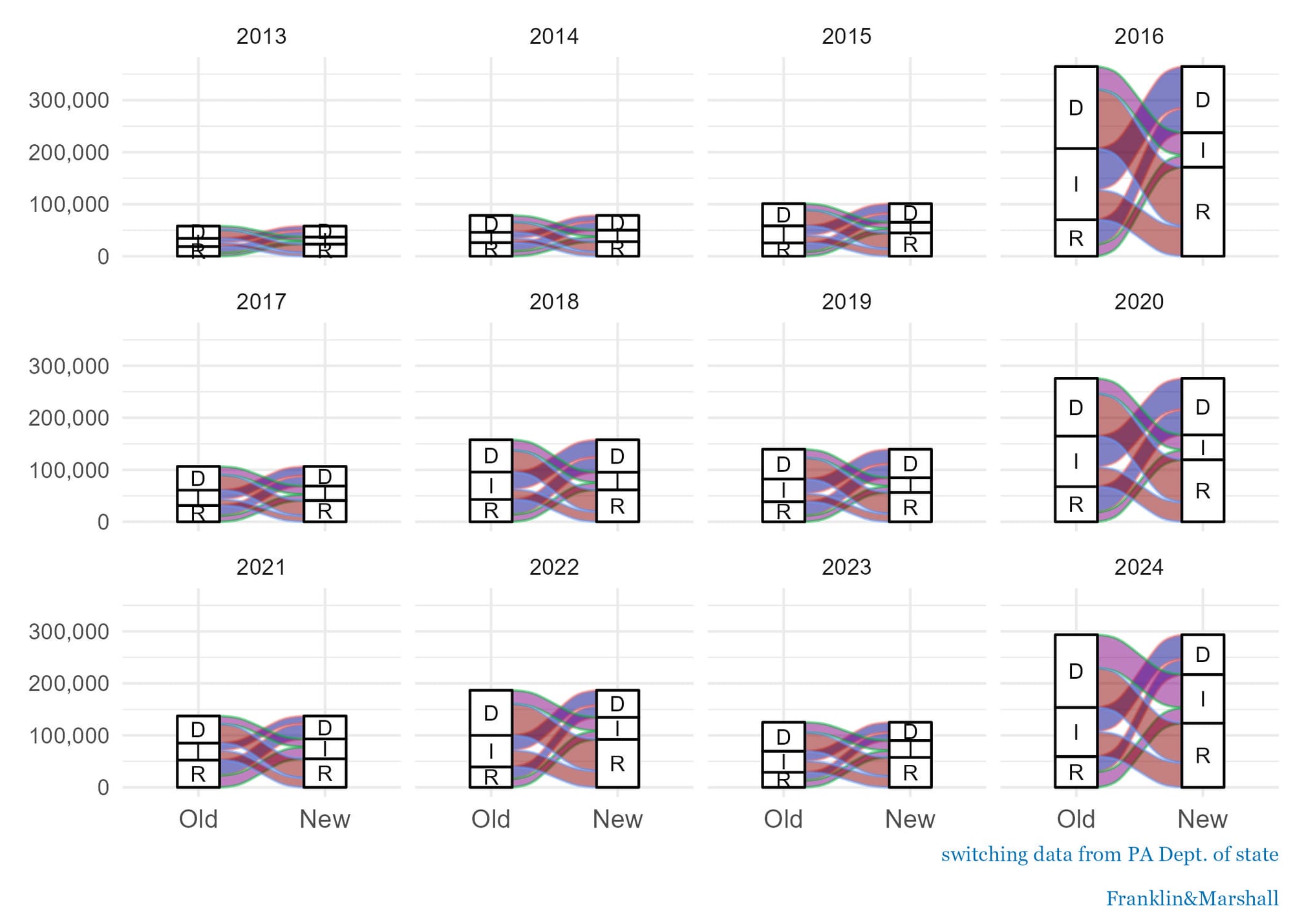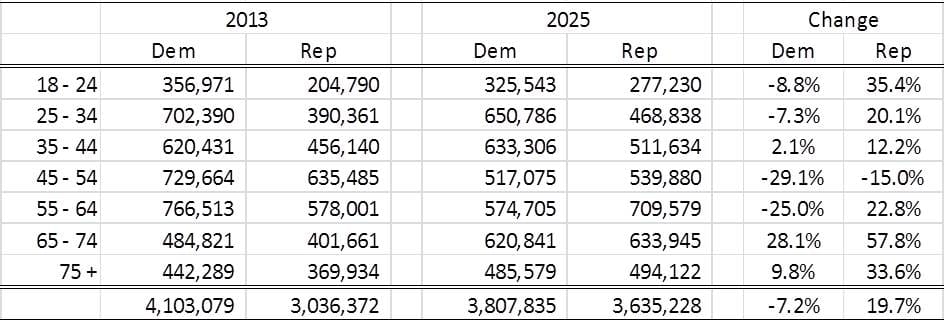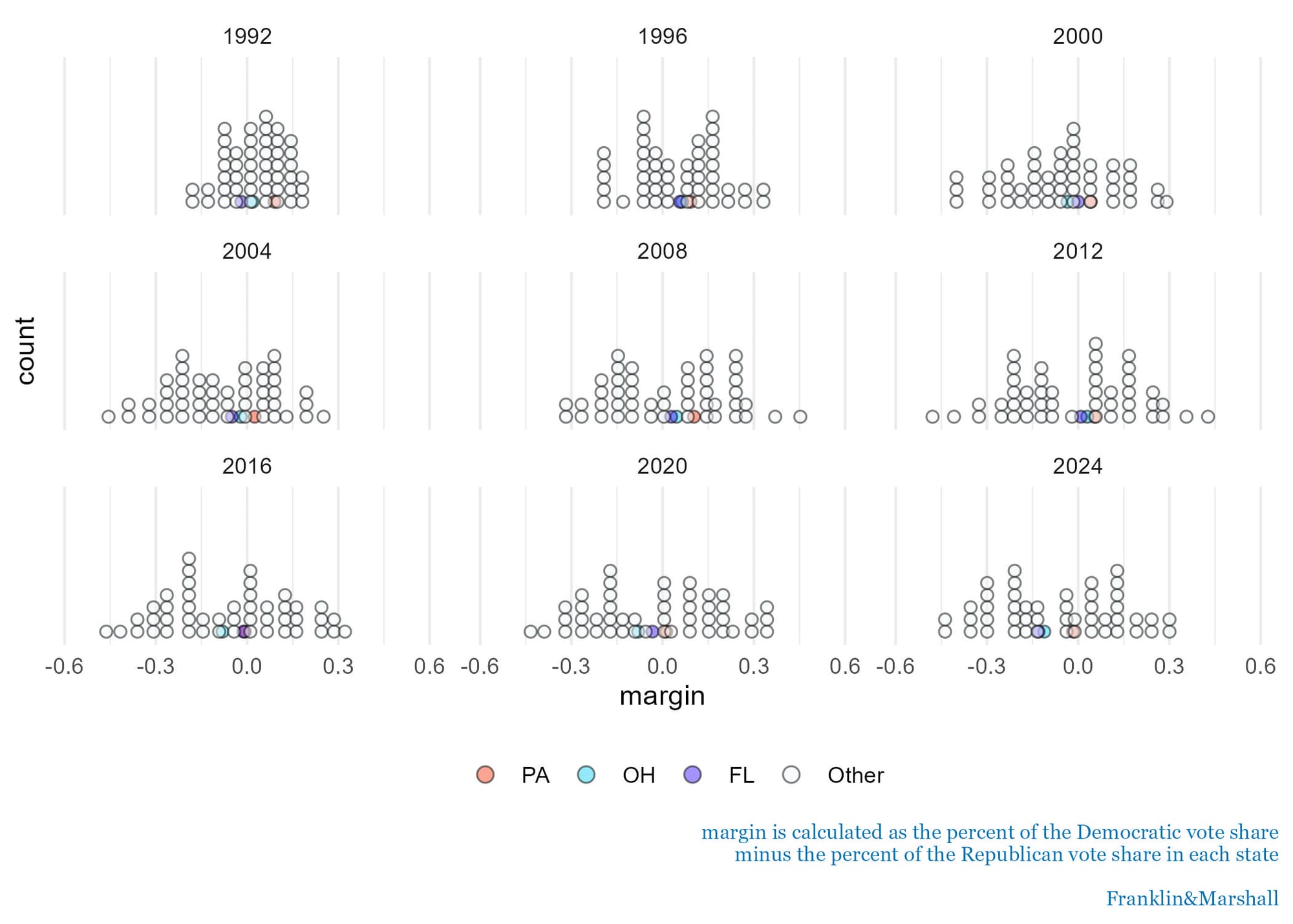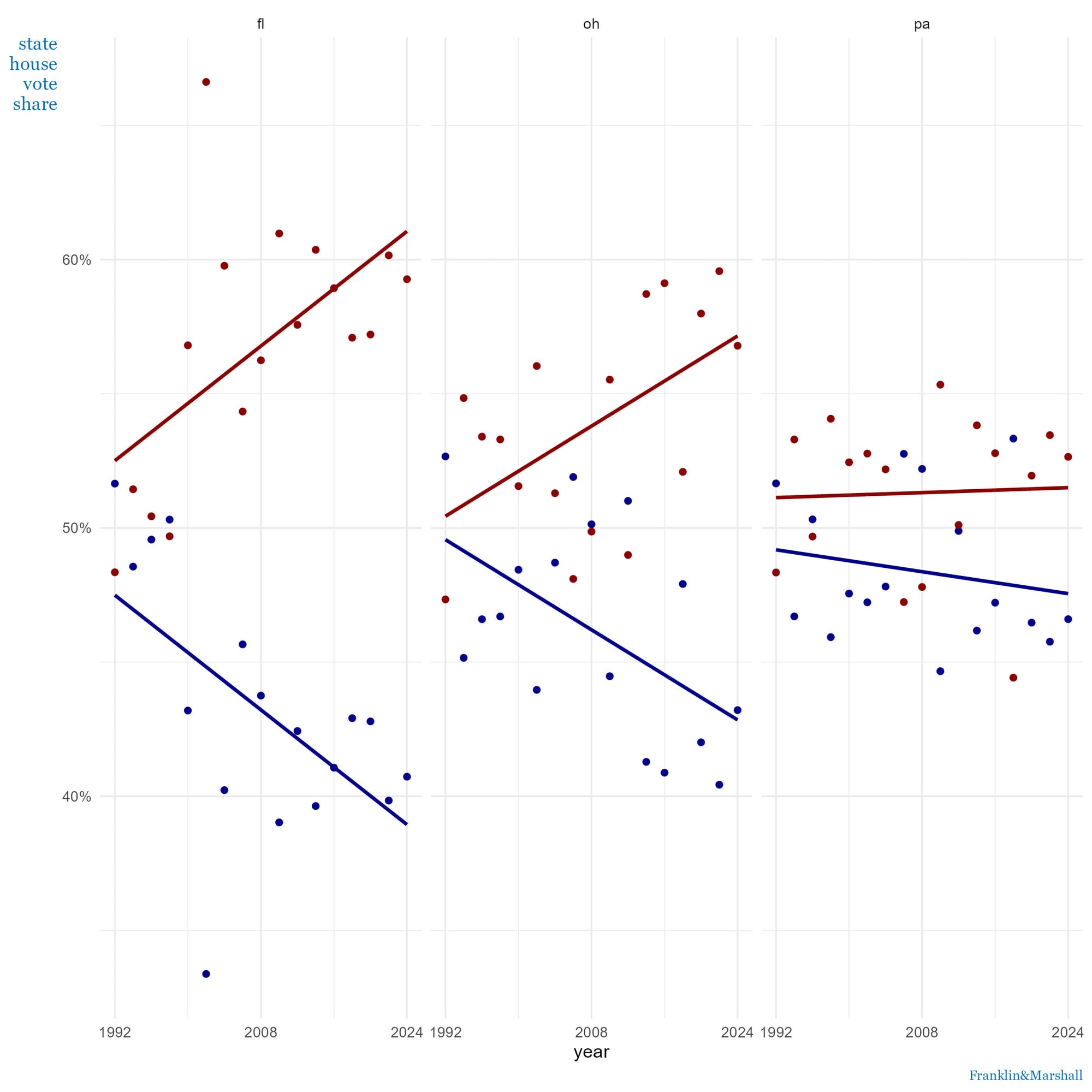Is Pennsylvania Still a Swing State?
Democratic voter registrations are shrinking. We dive deeper into party switching data to see what this means for Pennsylvania's swing state status.
Dear Readers,
Today’s newsletter discusses recent news stories about the state's changing party registration figures and how likely it is that party switching will alter Pennsylvania's swing state status. I hope you find it interesting.
I'm also writing to let you know that the next Franklin & Marshall College Poll will be released on October 9, 2025.
Thank you for reading,
Berwood Yost
The New York Times’ recent analysis of declining Democratic voter registration nationally initiated many related stories about Pennsylvania’s shrinking share of Democratic registrations.[1] The Times story noted Democrat losses and Republican gains while blaming the Democrats’ outdated voter registration activities as a large part of their problem.
However, voter registration changes are actually driven by three different groups: those newly registering, those who switch parties, and those who are removed from the rolls because they move, die, or no longer actively participate in voting. Much of the Times’ story focused on the advantages that Republicans have had registering new voters, with only a brief mention about party switchers. To better understand the current partisan landscape in Pennsylvania, this post takes a closer look at those who have switched parties.
Party Switching Behaviors in Pennsylvania Since 2013
The state has been collecting and sharing information about the annual movement of voters between the parties since 2013.[2] In that time period, just over two million Pennsylvanians switched their party affiliations.[3] Switching among registered voters has netted the Republican Party about 190,000 voters (875,000 moved to Republicans, 683,000 moved to Democrats, and 467,000 moved to unaffiliated or other). Put another way, 34% of those who changed their registration switched to Democrat, 43% switched to Republican, and 23% switched to unaffiliated.
Patterns in party switching behaviors are best seen by focusing on annual changes instead of the total change over all these years. Figure 1 displays the flow of party switchers in the state from 2013 to 2024 and makes three things clear. First, party switching was low prior to 2016. Second, switching behaviors are much more common in presidential election years. Third, Republicans held an advantage among switchers over most of the last decade except for 2014 and 2018, but registration changes during the Biden years in 2022, 2023, and 2024 produced the largest net annual advantages for Republicans during this period.

As I noted in February 2025, gains and losses in party registration are associated with presidential popularity. The second Bush term produced a steep decline in Republican registrations and the largest increase in Democratic registrations this century. Similarly, Joe Biden’s presidency produced major declines in Democratic registration. Notably, party switching has continued to favor Republicans this year, albeit narrowly, despite President Trump’s declining job approval ratings.[4] Republicans will become increasingly optimistic about their electoral prospects in the state if they continue to gain registrations even as the president’s job approval sinks.
The other trend in voter registration that must concern Democrats and delight Republicans is the Democratic registration decline among young voters. Today, Democrats have 83,000 fewer voters under 35 than they had in 2013, while Republicans have 150,000 more (Table 1). Still, the greatest Republican advantage comes from voters over 55 years of age—they have added a half million voters 55 and older to their rolls during the past decade.
Table 1. Pennsylvania Party Registration by Age Group, 2013 and 2025

Is Pennsylvania Still a Swing State?
Closing the huge gap in party registration has made Republicans rightfully excited that their electoral prospects in Pennsylvania are improving. Some of them believe that Pennsylvania is on its way to becoming the next Florida or Ohio, i.e., swing states that are now solidly Republican.[5]
Although it may be possible that Pennsylvanians are starting to abandon their practiced habits that support the state’s reputation as a swing state, that is unlikely in the near term. First, most of the stories about changing voter registration have missed or downplayed the essential fact that unaffiliated voters are the fastest growing group of voters in the state, doubling in size since 2000. These are the voters who will decide who wins in this state. With the two parties more evenly matched in their registration numbers, unaffiliated and third party voters will be more consequential.
Observers should also remember that voters in Pennsylvania are accustomed to competitive elections. In presidential elections going back to 1992, Pennsylvania has consistently been a bit more supportive of the Democratic candidates than have either Florida or Ohio (Figure 2). Even after all the shifts in registration just noted, the state’s voters have remained much more supportive of Democrats than have voters in the other two states, and in 2024 Pennsylvania was still among the most competitive group of states.

The results of state house elections also show how voter behaviors in these states have long differed. Voters in state legislative elections in Florida and Ohio have been moving away from Democrats for many election cycles, with clear movement starting to show up around 2008.[6] In contrast, the preferences of Pennsylvanians for their state legislative candidates have remained competitive and show little break with past practices.

Equally important, partisan shifting and sorting has left only a few states where a presidential campaign has a chance to sway enough voters to win, with Pennsylvania being at the top of that list. Campaigns will continue to spend money here to impact attitudes and drive turnout, and that spending and attention will ensure that the state’s presidential races remain competitive.
Clearly the partisan landscape has changed in Pennsylvania over the past decade, but the rapidly increasing number of unaffiliated voters, long-term voting behaviors and attitudes that support competition, and the self-fulfilling prophecy of being a swing state likely signal more competition in the state, not a turn to one party dominance.
NOTES
[1] The Democratic Party Faces a Voter Registration Crisis (8/20/2025).
[2] Data on party registrations can be found at https://www.pa.gov/agencies/dos/resources/voting-and-elections-resources/voting-and-election-statistics. The data used in this post come from the August 25, 2025 Pennsylvania Department of State county voter registration data file. The data in Table 1 comes from the 8/26/2013 file update and the 9/16/2025 update.
[3] There were 8.9 million registered voters in the state in 2024. State voter registration figures were as low as 7.6 million in 2002 and as high as 9.1 million in 2020. Data for new party registration can be found at: https://www.pavoterservices.pa.gov/AVR-Party-Breakdown.pdf.
[4] From January 1 through September 15, 2025, Republicans gained 43,682 switchers, Democrats gained 35,939 switchers, and 38,365 switched to unaffiliated. Combining all the switching data shows a net Republican gain of 14,340 voters, a net Democratic loss of 16,462, and a net gain of 2,182 for unaffiliated voters. This is the lowest number of switchers since 2017.
[5] A conservative activist said, “the data paints the picture that Republicans have the opportunity to turn Pennsylvania into the next Ohio.” Quoted in Will Pa. remain a swing state? Charles Thompson, Pennlive, September 8, 2025.
[6] Data for presidential elections were compiled by Stephen Medvic, The Honorable & Mrs. John C. Kunkel Professor of Government at Franklin & Marshall College, from https://uselectionatlas.org/. Data for the 1992 – 2016 legislative elections came from Klarner, Carl, 2024, "State Legislative Election Returns, 1967-2022", https://doi.org/10.7910/DVN/FJOGJB, Harvard Dataverse, V1, UNF:6:4on5FjrIT6VsAOBBbu+R+g==[ttps://dataverse.harvard.edu/dataset.xhtml?persistentId=doi:10.7910/DVN/FJOGJB]. Data for the 2018 – 2024 elections were compiled by David Dulio, Distinguished Professor, Department of Political Science, Oakland University. Raw returns were used in these calculations and no efforts were made to correct for open seats.
Franklin & Marshall College Poll Newsletter
Join the newsletter to receive the latest updates in your inbox.
